 полная версия
полная версияField Book of Western Wild Flowers

Chinese Pusley – Heliotropium Curassavicum.
Oreocarya multicaulis.
VERBENA FAMILY. Verbenaceae
A large family, widely distributed; herbs and shrubs; leaves opposite, or in whorls; flowers perfect, in clusters; calyx with four or five lobes or teeth; corolla with four or five united lobes, almost regular or two-lipped; stamens on the corolla, usually four, in two sets; ovary superior, with one style and one or two stigmas, when ripe separating into from two to four, one-seeded nutlets.
There are many kinds of Verbena, chiefly American; perennials; calyx tubular, with five teeth; corolla usually salver-form, with five lobes, usually slightly two-lipped; stigmas with two lobes, only the larger lobe fertile; fruit four nutlets. This is the Latin name of some sacred plant.
Wild Verbena
Verbèna Arizònica
Lilac
Spring
Arizona
This is very much like a garden Verbena, an attractive little plant, from four to six inches tall, with hairy stems and prettily shaped leaves, dull green, soft and hairy. The gay little flowers are about half an inch across, with a bright pinkish-lilac corolla, with a white or yellowish "eye," and a sticky-hairy calyx, and form a charming flat-topped cluster. This grows among the rocks, above the Desert Laboratory at Tucson and in similar places.
Common Vervain
Verbèna prostràta
Lilac
Spring, summer, autumn
California
A loosely-branching plant, from one to two feet tall, with dull green, hairy stems, dull green, soft, hairy leaves, and very small flowers in a long spike, too few open at one time to be effective. The corolla is lilac or bluish, often with a magenta tube and magenta "eye." This grows in dry open hill country.
MINT FAMILY. Labiatae
A very large family, with distinctive characteristics; widely distributed. Ours are herbs or low shrubs, generally aromatic, with usually square and hollow stems; leaves opposite, with no stipules; flowers perfect, irregular, in clusters, usually with bracts; calyx usually five-toothed, frequently two-lipped; corolla more or less two-lipped, upper lip usually with two lobes, lower lip with three; stamens usually four, in pairs, on the corolla-tube, alternate with its lobes; ovary superior, with four lobes, separating when ripe into four, small, smooth, one-seeded nutlets, surrounding the base of the two-lobed style, like the four nutlets of the Borage Family, but the flowers of the latter are regular. These plants are used medicinally and include many herbs used for seasoning, such as Sage, Thyme, etc.

Wild Verbena – V. Arizonica.
Common Vervain – Verbena prostrata.
There are a few kinds of Micromeria; trailing perennials; flowers small; calyx tubular, with five teeth; corolla two-lipped, with a straight tube; stamens four, all with anthers, not protruding. The Greek name means "small."
Yerba Buena, Tea-vine
Micromèria Chamissónis (M. Douglasii)
Lilac, white
Spring, summer
Cal., Oreg., Wash.
An attractive little plant, resembling the little eastern Gill-over-the-ground, with slender trailing stems, slightly downy foliage, and lilac or whitish flowers, about a quarter of an inch long. The calyx and corolla are hairy on the outside; the corolla has an erect upper lip, sometimes notched, and a spreading, three-lobed lower lip, and the stamens are four, the lower pair shorter. This is common in shady places near the coast. It has a pleasant aromatic fragrance and was used medicinally by California Indians, so it was called "good herb" by the Mission Fathers, and is still used as a tea by Spanish-Californians, who call it Yerba Buena del Campo, "field herb," distinguishing it from Yerba Buena del Poso, "herb of the well," the garden mint.
There are several kinds of Monardella, fragrant herbs, all western, chiefly Californian; leaves mostly toothless; flowers small, in terminal heads, on long flower-stalks, with bracts, which are often colored; calyx tubular, with five, nearly equal teeth; corolla with erect upper lip, two-cleft, lower lip with three, nearly equal lobes; stamens four, protruding, sometimes the lower pair longer.
Western Pennyroyal, Mustang Mint
Monardélla lanceolàta
Lilac
Summer
California
An attractive plant, pretty in color and form, with purplish, often branching stems, from six inches to over two feet high, smooth leaves, and small bright pinkish-lilac flowers, crowded in terminal heads, about an inch across, with purplish bracts. The outer ring of flowers blooms first and surrounds a knob of small green buds, so that the effect of the whole flower-head slightly suggests a thistle. This has a strong, pleasant smell like Pennyroyal and is abundant in Yosemite, and elsewhere in the Sierra Nevada foothills.
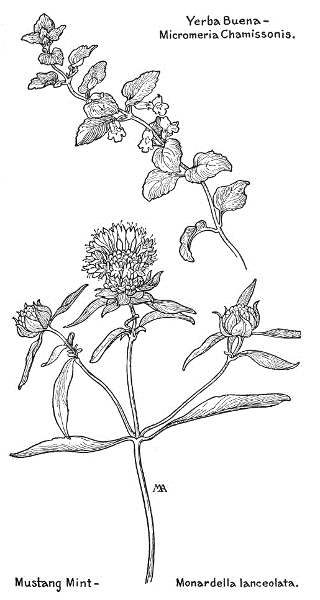
Yerba Buena – Micromeria Chamissonis.
Mustang Mint – Monardella lanceolata.
There are several kinds of Ramona, abundant in southern California; shrubby plants, with wrinkled leaves and flowers like those of Salvia, except for differences in the filaments; stamens two. They are very important honey-plants, commonly called Sage, and by some botanists considered to be a species of Salvia.
Desert Ramona
Ramòna incàna (Audibertia)
Blue
Spring
Southwest
A low desert shrub, from two to three feet high, varying very much in color. On the plateau in the Grand Canyon it is delicate and unusual in coloring, with pale gray, woody stems and branches and small, stiffish, gray-green, toothless leaves, covered with white down. The small flowers are bright blue, projecting from close whorls of variously tinted bracts, and have long stamens, protruding from the corolla-tube, with blue filaments and yellow anthers, and a blue style. The bracts are sometimes lilac, sometimes pale blue, or cream-color, but always form delicate pastelle shades, peculiar yet harmonizing in tone with the vivid blue of the flowers and with the pale foliage. This is strongly aromatic when crushed. In the Mohave Desert it is exceedingly handsome, but the coloring is often less peculiar, as the foliage is not quite so pale as in other places, such as the Grand Canyon, and the flowers vary from blue to lilac or white. It blooms in spring and when its clumps of purple are contrasted with some of the yellow desert flowers, clustered about the feet of the dark Joshua Trees which grow around Hesperia, the effect is very fine.
Humming-bird Sage
Ramòna grandiflòra (Audibertia)
Red
Spring
California
This is a handsome and very decorative plant, though rather coarse and sticky, with a stout, bronze-colored stem, which is woody at base, from two to three feet tall, and velvety, wrinkled leaves, from three to eight inches long, with scalloped edges and white with down on the under side. The flowers are an inch and a half long, with crimson corollas of various fine shades, which project from the crowded whorls of broad, bronze or purplish bracts, arranged in tiers along the stem. Sometimes there are as many as nine of these clusters and the effect of the whole is dark and very rich, especially in shady places. This is common in the hills, from San Francisco south. Humming-birds are supposed to be its only visitors.
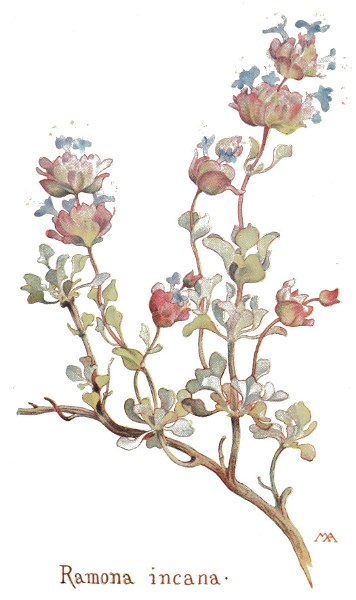
Ramona incana.
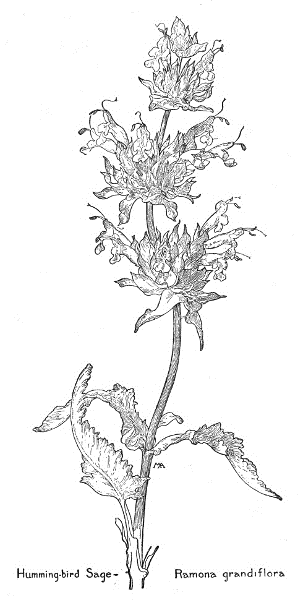
Humming-bird Sage – Ramona grandiflora.
White Ball Sage
Ramòna nívea (Audibertia)
Lilac
Spring
California
A very conspicuous, shrubby plant, much handsomer than Black Sage, from three to six feet high, with many, downy, stout, leafy stems, woody below, forming enormous clumps of pale foliage. The leaves are covered with pale down and are a delicate shade of sage-green and feel like soft thick velvet, and the mauve or lilac flowers, about three-quarters of an inch long, are arranged in a series of very round, compact balls along the stiff stalks. This is a honey-plant and smells strong of sage, and is common in the South, giving a beautiful effect of mingled mauve and gray.
White Sage
Ramòna polystàchya (Audibertia), (Salvia apiana)
White, lilac
Spring
California
Not so handsome as the last, but a very conspicuous plant, on account of its size and the pale tint of its foliage, though the flowers are too dull in color to be striking. It is shrubby and has a number of stems, which form a loose clump from three to six feet high, with rather leathery, resinous leaves, all but the upper ones with scalloped edges, and the whole plant is covered with fine white down, so that the general effect is pale gray, blending with the white or pale lilac flowers and purplish buds. The flowers are about half an inch long and are very queer in form, for the only conspicuous part is the lower lip, which is very broad with a ruffled edge and is turned straight up and backward, so as to conceal almost all the rest of the flower. The long jointed stamens, which are borne on the lower lip, stand out awkwardly like horns and from one side of the flower's face a long white pistil sticks out, with something the effect of a very long cigar hanging out of the corner of its mouth! All these eccentric arrangements are apparently for the purpose of securing cross-pollination from the bees, which frequent these flowers by the thousand, as this is a famous bee-plant and the white honey made from it is peculiarly delicious. It grows abundantly in valleys and on hillsides, from Santa Barbara to San Diego, and has a very strong disagreeable smell.

White Ball Sage – Ramona nivea.
White Sage – R. polystachya.
Black Sage, Ball Sage
Ramòna stachyoìdes (Audibertia)
Lilac, white
Spring
California
A conspicuous shrubby plant, from three to six feet high, with stiffish leaves, which are downy on the under side, wrinkled on the upper, and grayish-green and downy when young, but become smoother and dark green as they grow older. The flowers are pale lilac or white, half an inch long, and the calyx-lobes and bracts are tipped with bristles. The compact flower clusters, usually about five in number and rather small, are arranged in tiers on long slender stalks, which stand up stiffly all over the bush. This is common on southern hillsides, often forming dense thickets for long distances, smells strong of sage and is an important bee-plant.
There are several kinds of Hyptis, very abundant in South America and Mexico, but only a few reaching the southwestern border of our country; the calyx with five almost equal teeth; the corolla short, the lower lip sac-shaped and abruptly turned back, the other four lobes nearly equal and flat; the stamens four, included in the sac of the lower lobe.
Hyptis
Hýptis Émoryi
Purple
Spring
Arizona
A shrub, from three to five feet high, with very pale, roundish, woody stems and branches and small, very pale gray leaves, thickish and soft, covered with white woolly down. The little fragrant, bluish-purple flowers, with white woolly calyxes, are crowded in close clusters about an inch long. Only a few flowers are out at one time and they are too small to be pretty, but the effect of the shrub as a whole is rather conspicuous and attractive, on account of its delicate coloring, the lilac of the flower-clusters harmonizing with the gray foliage, which gives out a very strong smell of sage when crushed. This grows among the rocks above the Desert Laboratory at Tucson and in similar places, blooming in early spring and much visited by bees.
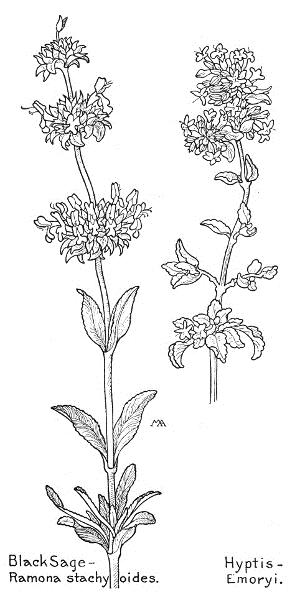
Black Sage – Ramona stachyoides.
Hyptis – Emoryi.
Self-heal
Prunélla vulgàris
Purple
Spring, summer, autumn
Across the continent
There are several kinds of Prunella, widely distributed, but this is the only one common in this country and is probably not native. It is abundant in dampish places, in the far West often staying green all winter, a perennial, sometimes hairy, from two inches to over a foot high. The leaves, often obscurely toothed, have leaf-stalks and the small flowers are crowded in a series of whorls, with purplish bracts and forming a spike or head. The calyx is two-lipped, with five teeth and often purplish, and the corolla is purple, pink, or occasionally white, with an arched upper lip, a spreading, three-lobed lower lip, and four stamens, under the upper lip of the corolla, the lower pair longer. This is usually not pretty, but in favorable situations in the West is often handsome, with brighter-colored, larger flowers. The name, often spelled Brunella, is said to be derived from an old German word for an affection of the throat, which this plant was supposed to cure. There is a picture in Mr. Mathews' Field Book.
There are many kinds of Stachys, widely distributed; herbs, often hairy, with a disagreeable smell; the calyx with five, nearly equal teeth; the corolla with a narrow tube, the upper lip erect, the lower lip spreading and three-lobed, the middle lobe longest; the stamens four, in pairs, usually under the upper lip of the corolla.
Hedge Nettle
Stàchys ciliàta
Magenta
Spring, summer
Northwest
This is a handsome plant, with a stout, rough, hairy stem, over two feet tall, and very bright green leaves, which are thin in texture but velvety. The flowers are in whorls, making a large cluster, and have a purplish calyx, smooth or with a few stiff hairs, and a corolla about an inch long, deep pink or magenta, sometimes spotted with white inside. Though the flowers are rather crude in color, they contrast finely with the bright green foliage. S. coccínea is a very handsome kind, with a tubular scarlet corolla, and grows in the mountain canyons of Arizona.

Hedge Nettle Stachys ciliata.
Common Hedge Nettle
Stàchys bullàta
Pink, purple
Spring, summer
Wash., Oreg., Cal.
This is common and varies in appearance, being often a coarse-looking weed, but sometimes the flowers are pretty. The rough, hairy stem is about a foot tall, the wrinkled leaves are soft and more or less hairy, and the flowers are about half an inch long, usually pale purplish-pink or purple, streaked and specked with deeper color, but are sometimes bright pink and then the long clusters are quite effective, growing in the road-side hedges. The plant is aromatic when crushed.
There are many kinds of Scutellaria, widely distributed; bitter herbs, some shrubby, with blue or lilac flowers; the calyx with two lips, the upper one with a protuberance on its back; the corolla smooth inside, the upper lip arched, sometimes notched, the lower lip more or less three-lobed; the stamens four, under the lip, all with anthers, the upper pair hairy. The curious helmet-shaped calyx, in which the seeds are generally enclosed at maturity, suggests the common names, Skullcap and Helmet-flower.
Skullcap
Scutellària angustifòlia
Blue
Spring, summer
Cal., Oreg., Wash.
A pleasing plant, from six inches to over a foot tall, not aromatic, with almost smooth leaves, most of them toothless. The flowers are pretty, though not striking, in pairs from the angles of the leaves, with a purplish-blue corolla, nearly an inch long, with a white tube, the lower lip woolly inside. The calyx is curiously shaped and after the flower drops off resembles a tiny green bonnet. When these little calyxes are pinched from the sides they open their mouths and show the seeds inside. This is quite common throughout the Sierras. S. antirrhinoìdes is similar, growing in Utah and the Northwest. S. Califórnica has cream-white flowers, less than an inch long, the lower lip hairy inside, and downy leaves, narrow at base, the lower leaves purplish on the under side and more or less toothed, the upper ones toothless. It grows in open woods in the Coast Ranges and Sierra Nevada mountains. S. tuberòsa is from three to five inches high, with tuberous rootstocks; the leaves more or less oval, downy, thin in texture, with a few teeth, the lower ones purplish on the under side, with long leaf-stalks, the flowers dark blue, about three-quarters of an inch long, each pair, instead of standing out at opposite sides of the stem, generally turn sociably together, first to one side and then to the other. This blooms in spring and grows in the Coast Ranges of California and Oregon.
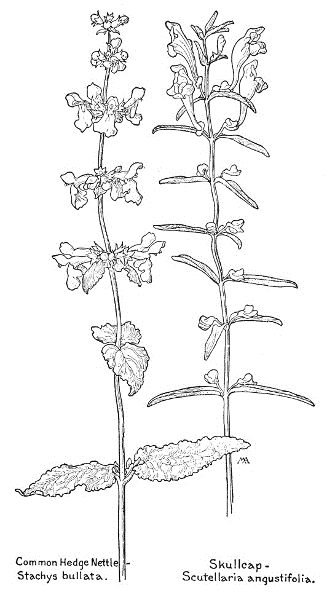
Common Hedge Nettle – Stachys bullata.
Skullcap – Scutellaria angustifolia.

Bladder-bush
Salazària Mexicàna
Blue and white
Spring
Southwest
This is the only kind, a very curious spiny desert shrub, about three feet high, varying a great deal in general appearance in different situations. The stems and foliage are gray-green and imperceptibly downy and the flowers are over three-quarters of an inch long, with a corolla which is hairy outside and has a lilac and white upper lip and a dark blue lower one. The calyxes become inflated and form very curious papery globes, over half an inch in diameter, very pale in color, tinged with yellow, pink, or lilac, and extremely conspicuous. In the desert around Needles, in California, the general form of the shrub is very loose and straggling, with slender twisting branches and small, pale gray-green leaves, both flowers and leaves very scanty and far apart, so that the bunches of bladder-like pods are exceedingly conspicuous. In the Mohave Desert it becomes a remarkably dense shrub, a mass of dry-looking, criss-cross, tangled branches, spiky twigs, and dull green leaves, speckled all over with the dark blue and white flowers and the twigs crowded with pods. Sometimes the flowers are magenta instead of blue, but are all alike on one bush. The stems are not square, as in most Mints. The drawing is of a plant at Needles.

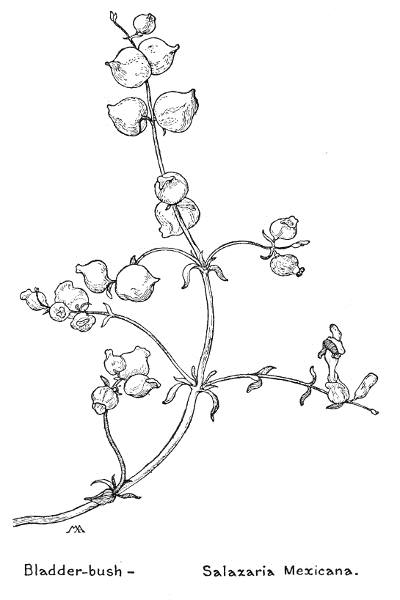
Bladder-bush – Salazaria Mexicana.
There are only a few kinds of Sphacele.
Pitcher Sage, Wood-balm
Sphácele calycìna
White
Spring, summer
California
This is a rather handsome shrubby plant, from two to five feet high, woody at base, with many stout, leafy, woolly or hairy stems, and rather coarse leaves, hairy, more or less wrinkled and toothed, and rather dark green. The flowers are over an inch long, in pairs along the upper stem, something the shape of a Monkey-flower, with a five-toothed calyx and a corolla with four, short, spreading lobes and the fifth lobe much longer and erect, the tube broad and dull-white, with a hairy ring at the base inside, the lobes tinged with pink or purple; the stamens four, one pair shorter. After the flowers have faded the large, pale green, inflated calyxes, veined with dull purple, become conspicuous. If the flowers were brighter in color this would be very handsome. It is strongly but rather pleasantly aromatic and grows on dry hills in southern California. The name is from the Greek, meaning "sage," as these plants have sage-like foliage and smell, but the flowers are quite different.
There are several kinds of Salvia, widely distributed, herbs or shrubs; flowers usually in whorls, with bracts; upper lip of the corolla erect, seldom two-lobed, lower lip spreading and three-lobed; resembling Ramona, except that the two stamens have filaments which are apparently two-forked, one fork bearing an anther cell and the other only the mere rudiment of an anther; the smooth nutlets are mucilaginous when wet. The Latin name means "to save," as some kinds are medicinal.
Thistle Sage, Persian Prince
Sálvia carduàcea
Lilac
Spring, summer
California
A fantastically beautiful and decorative plant, very individual in character. The stout purplish stem, a foot or two tall and covered with white wool, springs from a rosette of thistle-like leaves of palest green, so thickly covered with cushions of white wool that they appear to be inflated, their teeth tipped with brown spines. The stem bears a series of flower-clusters, resembling large, round, pale balls of wool, pierced here and there by long prickles and encircled by lovely flowers, so etherial that they appear almost to hover in the air. They are each about an inch long, the corolla clear bright lilac with an erect upper lip with two lobes, their fringed tips crossed one over the other, and the lower lip with small side lobes and a very large, fan-shaped, middle lobe, which is delicately fringed with white. The pistil is purple and the anthers are bright orange, which gives a piquant touch to the whole color scheme of pale green and lilac. There are several tiers of these soft yet prickly balls, which suggest the pale green turbans of an eastern potentate, wreathed with flowers. The buds poke their little noses through the wool, in a most fascinating way, like babies coming out of a woolly blanket, and fresh buds keep on coming through and expanding as the faded blossoms fall, so that these flowers last longer in water than we would expect from their fragile appearance. The plants when they are crushed give out a rather heavy smell of sage, with a dash of lemon verbena. They grow on the dry open plains of the South.
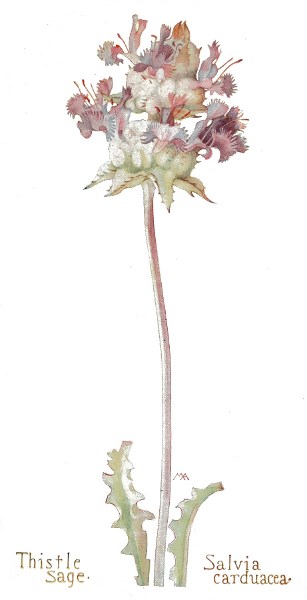
Thistle Sage – Salvia carduacea.
Pitcher Sage – Sphacele calycina.

Chia
Sálvia columbàriae
Blue
Spring
Southwest
This is an odd-looking plant, but is often quite handsome. The stout purplish stem, from six inches to over two feet tall, springs from a cluster of rough, very dull green leaves, sometimes so wrinkled as to look like the back of a toad, and bears a series of round, button-like heads, consisting of numerous, purple, bristly bracts, ornamented with small, very bright blue flowers. Though the flowers are small, the contrast between their vivid coloring and the purple or wine-colored bracts is very effective. The seeds have been for centuries an important food product among the aborigines and this plant in ancient Mexico was cultivated as regularly as corn, the meal being extremely nourishing and resembling linseed meal. The Mission Fathers used it for poultices and it is still in demand among the Spanish-Californians. This grows on dry hillsides and smells of sage.

